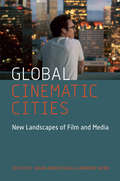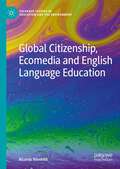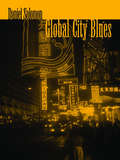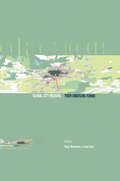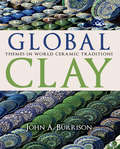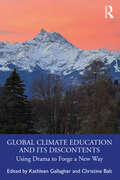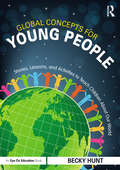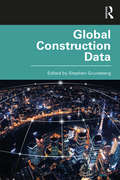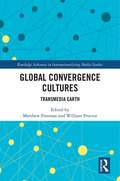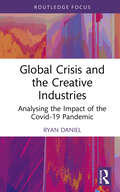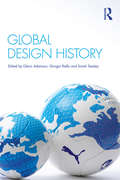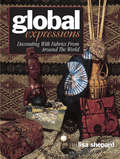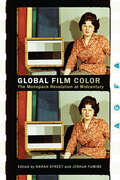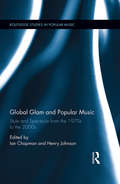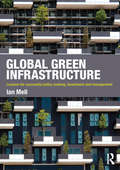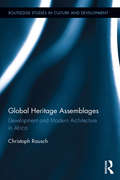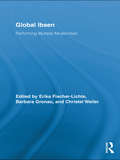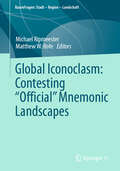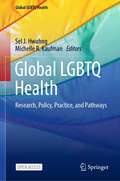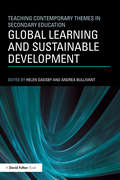- Table View
- List View
Global Cinematic Cities: New Landscapes of Film and Media
by Lawrence Webb Andersson JohanCinema and audiovisual media are integral to the culture, economy and social experience of the contemporary global city. But how has the relationship between cinema and the urban environment evolved in the era of digital technology, new media and globalization? And what are the critical tools and concepts with which we can grasp this vital interconnection between space and screen, viewer and built environment? Engaging with a rapidly transforming urban world, the contributions to this collection rethink the 'cinematic city' at a global scale. By presenting a global constellation of screen cities within one volume, the book encourages juxtapositions and comparisons across the North and South to capture the global city and its dynamics of exchange, hybridity, and circulation. The contributions examine film and screen cultures in a range of locations spanning five continents: Antibes, Beijing, Buenos Aires, Busan, Cairo, Caracas, Copenhagen, Jakarta, Kolkata, Lagos, Los Angeles, Malmö, Manila, Mumbai, Nairobi, Paris, Seoul, Sète, and Shanghai. The chapters address topics that range across the contemporary film and media landscape, from popular cinema, art cinema, and film festivals to serial television, public screens, multimedia installations, and video art. Contributors: Chris Berry, Yomi Braester, Jinhee Choi, Pei-Sze Chow, Thomas Elsaesser, Malini Guha, Jonathan Haynes, Will Higbee, Igor Krstic, Christian B. Long, Joanna Page, Lawrence Webb.
Global Cinematic Cities: New Landscapes of Film and Media
by Johan Andersson Lawrence WebbCapturing a rapidly transforming urban world, this collection investigates the emerging dynamics between filmmaking and urban change on a global scale. It surveys film, media and screen cultures in Buenos Aires, Beijing, Berlin, Cairo, Copenhagen, Delhi, Kolkata, Lagos, Los Angeles, Malmö, Manila, Paris, Rome, and Shanghai. Drawing on work in film and urban studies, the volume innovatively rethinks the "cinematic city" and argues for its ongoing relevance. Film festivals, transnational production, public screens, media ecologies, nostalgia, cinephilia, infrastructure, and informal economies illuminate the juxtaposition of cinema and urban space. Works covered include The Bourne Legacy (2012), Her (2013), Medianeras (2011), Last Flight to Abuja (2012), Maach, Mishti, and More (2013), The Future of the Past (2012), Good Morning Aman (2009), Couscous (2007), the transnational television production The Bridge, and Chinese video art.
Global Citizenship, Ecomedia and English Language Education (Palgrave Studies in Education and the Environment)
by Ricardo RömhildThis book presents a unique framework for the inclusion of ecomedia in the English language classroom to help learners cultivate global citizenship. Foregrounding learner agency in a world at risk, the author proposes a framework that hinges on human rights and critical eco-cosmopolitanism to help learners position themselves in discourses on climate change and act for transformation. The book discusses eco-documentaries as multimodal, factional texts against the background of cutting-edge research, refuting a definition based on the binary of fiction and non-fiction. Translating the insights gained from this discussion to the language education context, learners are conceptualised as active designers of meaning making when engaged with eco-documentaries. Based on this discussion, the book puts forth an innovative, multiliteracies-informed concept which is embedded in a sustainability-oriented pedagogy of hope, which encourages learners to learn and practice languages of hope and advocacy. The book will be of interest to scholars in the fields of ecopedagogy, sustainability education, global citizenship education and cultural learning, film pedagogy and language education, as well as language educators.
Global City Blues
by Daniel Solomon"This is a book about the making of cities and the buildings that compose them. It is about the conditions under which an architect engaged in those activities now works, how those conditions evolved and why they are changing. It is about the qualities of life that are threatened by the ways cities are built at the beginning of the 21st century and intelligent response to those threats. It is about why the city planning ideas and the cultural cuisinart that came in the box with modern architecture are a lingering menace." -- from Global City Blue.In Global City Blues, renowned architect Daniel Solomon presents a perceptive overview and an insightful assessment of how the power and seductiveness of modernist ideals led us astray. Through a series of independent but linked essays, he takes the reader on a personal picaresque, introducing us to people, places, and ideas that have shaped thinking about planning and building and that laid the foundation for his beliefs about the world we live in and the kind of world we should be making.As an alternative, Daniel Solomon discusses the ideas and precepts of New Urbanism, a reform movement he helped found that has risen to prominence in the past decade. New Urbanism offers a vital counterbalance to the forces of sprawl, urban disintegration, and placelessness that have so transformed the contemporary landscape.Global City Blues is a fresh and original look at what the history of urban form can teach us about creating built environments that work for people.
Global City Regions: Their Emerging Forms
by Roger Simmonds Gary HackA unique comparative study based on funded research, of eleven city regions across three continents looking at changes over the last 30 years. Detailed changes in land use are presented here with series of maps prepared especially for the study. The socio-economic and physical forms of city regions have been examined for comparative study and the findings will be of interest to all those concerned with urban development in their professional and academic work. The book features numerous maps which underline research findings. Cities covered are: Ankara, Bangkok, Boston, Madrid, Randstad, San Diego, Chile, Sao Paulo, Seattle and the Central Puget, Taipei, Tokyo, West Midlands.
Global Clay: Themes in World Ceramic Traditions
by John A. BurrisonFor over 25,000 years, humans across the globe have shaped, decorated, and fired clay. Despite great differences in location and time, universal themes appear in the world’s ceramic traditions, including religious influences, human and animal representations, and mortuary pottery. In Global Clay: Themes in World Ceramic Traditions, noted pottery scholar John A. Burrison explores the recurring artistic themes that tie humanity together, explaining how and why those themes appear again and again in worldwide ceramic traditions. The book is richly illustrated with over 200 full-color, cross-cultural illustrations of ceramics from prehistory to the present. Providing an introduction to different styles of folk pottery, extensive suggestions for further reading, and reflections on the future of traditional pottery around the world, Global Clay is sure to become a classic for all who love art and pottery and all who are intrigued by the human commonalities revealed through art.
Global Clay: Themes in World Ceramic Traditions
by John A. BurrisonFor over 25,000 years, humans across the globe have shaped, decorated, and fired clay. Despite great differences in location and time, universal themes appear in the world's ceramic traditions, including religious influences, human and animal representations, and mortuary pottery. In Global Clay: Themes in World Ceramic Traditions, noted pottery scholar John A. Burrison explores the recurring artistic themes that tie humanity together, explaining how and why those themes appear again and again in worldwide ceramic traditions. The book is richly illustrated with over 200 full-color, cross-cultural illustrations of ceramics from prehistory to the present. Providing an introduction to different styles of folk pottery, extensive suggestions for further reading, and reflections on the future of traditional pottery around the world, Global Clay is sure to become a classic for all who love art and pottery and all who are intrigued by the human commonalities revealed through art.
Global Climate Education and Its Discontents: Using Drama to Forge a New Way
by Kathleen Gallagher Christine BaltThis innovative and practical book offers pedagogical tools to show how drama can be used in educational settings to advance a relational, action-oriented, interdisciplinary, and creative climate education attuned to the social and emotional effects of the climate emergency. Based on a six-year ethnographic research study taking place with teachers, artists, community leaders, and young people globally, and taking its lead from the following provocation – can performance become a site for new imaginaries for socio-ecological justice? – the book explores the unique conceptual and pedagogical ‘discontents’ of climate education across geographically and culturally distinct sites of learning. It also examines how artful engagement through drama pedagogies can open up more collective, critical, and hopeful forms of thinking and being.The book is divided into two sections. The first part of the book, Local engagements and encounters, consists of chapters that conduct an in-depth appraisal of the local artistic work from each site, examining how matters of socio-ecological justice are given fresh urgency and complexity through the application of performance as pedagogy. The second part of the book, Pedagogical and artistic innovations, offers substantive praxis chapters on the drama-based pedagogical methods employed in the research. In these chapters, the world-building capacities of theatre-making offer up new, performative pedagogical orientations to the climate emergency beyond those of critique.Global Climate Education and Its Discontents: Using Drama to Forge a New Way is valuable reading for scholars interested in the ontological and epistemological dimensions of the climate emergency, especially within and across the following fields: drama, theatre and performance studies, applied theatre and drama education, educational research, and children/childhood and youth studies. The book also invites a readership of teachers and teacher-educators who are interested in applying drama pedagogies in the classroom to explore matters of socio-ecological justice and the climate crisis.
Global Concepts for Young People: Stories, Lessons, and Activities to Teach Children About Our World
by Becky HuntLearn how to teach global concepts and use them to increase critical thinking across the curriculum. In this new book from popular consultant Becky Hunt, you’ll get ready-to-use lesson plans, stories, and activities to help you teach five key global concepts—Change, Interdependence, Culture, Scarcity, and Power. Aligned with both the C3 Social Studies Framework and the Common Core State Standards for English Language Arts, these engaging lesson plans encourage critical thinking skills that will lead to increased creativity in problem solving. This book is an essential resource for teachers looking to: Create a framework to teach young people global concepts that will help them analyze and understand the world. Present stories and lessons connected to real-world issues that inspire students to develop innovative solutions. Engage students in lessons that will help them to understand and celebrate people from different cultures at home and around the world. Shape students into global citizens with an understanding of the world and a desire to bring about change. Special features include anchor stories, games, graphic organizers, and critical-thinking questions. Many of the tools are available as eResources on our website, www.routledge.com/9781138237940, so you can print and use them in your classroom immediately.
Global Construction Data
by Stephen GrunebergGlobal construction data is vital for contractors, governments, international organisations, policy makers, academic researchers and statisticians. As the global population of the world expands, the sustainability of the built environment raises the political agenda and the need to manage infrastructure and buildings in both urban and rural contexts becomes ever more pressing. How much more can the built environment grow and how can it be managed sustainably? This edited volume addresses how we can find a possible way through the inconsistencies between national construction data sets to devise a consistent approach to national construction data to further the global sustainability agenda and inform policy making. This search begins in Part I, which looks at the methods and definitions used in construction statistics in different countries. Part II considers examples of different types of construction data from the cost of materials, measuring work on high rise buildings and existing stock. In Part III, the authors consider construction data internationally, beginning with the problem of comparing data in different countries using exchange rates and purchasing power parities (PPPs), comparing innovation processes in different countries and looking at the provision of building design internationally. In Part IV, the international theme is continued by comparing accounting practices and company performance in different countries and concludes with an international comparison of construction industries. This book raises awareness of the significance of the construction industry globally and the importance of data to measure it. It informs the discussion of the best ways of handling the consequences of policies affecting the built environment and the effect of the built environment on the rest of the economy and society. It is essential reading for international economists, construction industry consultants, policy makers, construction statisticians and academics.
Global Convergence Cultures: Transmedia Earth (Routledge Advances in Internationalizing Media Studies)
by William Proctor Matthew FreemanToday’s convergent media industries readily produce stories that span multiple media, telling the tales of superheroes across comics, film and television, inviting audiences to participate in the popular universes across cinema, novels, the Web, and more. This transmedia phenomenon may be a common strategy in Hollywood’s blockbuster fiction factory, tied up with digital marketing and fictional world-building, but transmediality is so much more than global movie franchises. Different cultures around the world are now making new and often far less commercial uses of transmediality, applying this phenomenon to the needs and structures of a nation and re-thinking it in the form of cultural, political and heritage projects. This book offers an exploration of these national and cultural systems of transmediality around the world, showing how national cultures – including politics, people, heritage, traditions, leisure and so on – are informing transmediality in different countries. The book spans four continents and twelve countries, looking across the UK, Spain, Portugal, France, Estonia, USA, Canada, Colombia, Brazil, Japan, India, and Russia.
Global Crisis and the Creative Industries: Analysing the Impact of the Covid-19 Pandemic (Routledge Focus on the Global Creative Economy)
by Ryan DanielWorkers in the creative industries are highly motivated, resilient, and innovative and these characteristics have come to the fore during the global health and resultant economic crises enveloping the world. This shortform book analyses transformation in the arts as a result of this era of polycrisis. The author interrogates public policy, legislative developments, and financial support systems to assist the arts sector around the world. Utilising interview responses from various artis and creatives, the book takes the impact of the Covid-19 pandemic on the global creative industries as its central case study. It looks at the historical relationship between art and times of global crises, the policy initiatives implemented around the world in response to Covid-19 to rescue and support creative industries, explores the ways in which audiences, artists, and creatives responded during the first year of the pandemic, and looks towards future opportunities for the creative industries sector. The book also highlights the importance of higher education for the future creative industries workforce. Providing a concise, yet holistic interpretation of the early impact of the pandemic, the book summarises recent developments, and proposes future directions relevant to students and scholars involved in the creative economy.
Global Design History
by Giorgio Riello Glenn Adamson Sarah TeasleyGlobalism is often discussed using abstract terms, such as ‘networks’ or ‘flows’ and usually in relation to recent history. Global Design History moves us past this limited view of globalism, broadening our sense of this key term in history and theory. Individual chapters focus our attention on objects, and the stories they can tell us about cultural interactions on a global scale. They place these concrete things into contexts, such as trade, empire, mediation, and various forms of design practice. Among the varied topics included are: the global underpinnings of Renaissance material culture the trade of Indian cottons in the eighteenth-century the Japanese tea ceremony as a case of ‘import substitution’ German design in the context of empire handcrafted modernist furniture in Turkey Australian fashions employing ‘ethnic’ motifs an experimental UK-Ghanaian design partnership Chinese social networking websites the international circulation of contemporary architects. Featuring work from leading design historians, each chapter is paired with a ‘response’, designed to expand the discussion and test the methodologies on offer. An extensive bibliography and resource guide will also aid further research, providing students with a user friendly model for approaches to global design. Global Design History will be useful for upper-level undergraduate and postgraduate students, academics and researchers in design history and art history, and related subjects such as anthropology, craft studies and cultural geography.
Global Expressions: Decorating With Fabrics from Around the World
by Lisa ShepardThe fabrics we use to create clothing and home decor reflect our culture and heritage. This book takes readers around the world as it introduces them to fabric techniques through interviews with experts in the field. From sadza batik in Zimbabwe to Japanese sashiko quilting, the authentic method for creating each fabric is explained, along with simplified instructions for recreating the look. Color photographs, patterns, designs and stencils assist readers in utilizing the fabric for unique home decor. Includes an extensive appendix, a detailed glossary and traceable patterns. This book features 12 fabric styles and 15 projects. It offers information on the authentic fabric, how it is created and its place in the culture of the country. Global Expressions presents easy-to-follow directions on how to recreate the fabric.
Global Film Color: The Monopack Revolution at Midcentury
by William Carroll Joshua Yumibe Philip Cavendish Kathryn Millard Sarah Street Laura Major Ranjani Mazumdar Stefan Soloman Kirsty Sinclair Dootson Kamalika Sanyal Heather Heckman Lydia Pappas Elena Gipponi Rafael de Luna Freire Josephine Diecke Linda Chen ZhangGlobal Film Color: The Monopack Revolution at Midcentury explores color filmmaking in a variety of countries and regions including India, China, Japan, and Russia, and across Europe and Africa. Most previous accounts of color film have concentrated on early 20th century color processes and Technicolor. Far less is known about the introduction and application of color technologies in the period from the mid-1940s to the 1980s, when photochemical, “monopack” color stocks came to dominate global film markets. As Eastmancolor, Agfacolor, Fujicolor and other film stocks became broadly available and affordable, national film industries increasingly converted to color, transforming the look and feel of global cinema. Covering a broad range of perspectives, the chapters explore themes such as transnational flows, knowledge exchange and transfer, the cyclical and asymmetrical circulation of technology in a global context, as well as the accompanying transformation of color film aesthetics in the postwar decades.
Global Geographies of Post-Socialist Transition: Geographies, societies, policies (Routledge Studies in Human Geography)
by Tassilo HerrschelSince the formal raising of the Iron Curtain, there has been much interest in post-socialism and the process of post-socialist transition. This timely book provides a systematic review and analysis of the process of ‘transition’. Herrschel: explores recent theories, concepts and debates on post-socialism and the notion of transition provides a systematic, topical account of post-socialist transitions around the world, as evidence by social, economic, and political processes examines case studies of post-socialist transition in east and Central Europe, the former Soviet Union, Asia and South-East Asia, and Africa and Latin America brings together theoretical and practical aspects by examining what lessons can be learned from recent experiences. Global Geographies of Post-Socialist Transition provides a truly global comparative account of the meaning and processes of post-socialist transition and will be an invaluable resource for all those interested in this area.
Global Glam and Popular Music: Style and Spectacle from the 1970s to the 2000s (Routledge Studies in Popular Music)
by Henry Johnson Ian ChapmanThis book is the first to explore style and spectacle in glam popular music performance from the 1970s to the present day, and from an international perspective. Focus is given to a number of representative artists, bands, and movements, as well as national, regional, and cultural contexts from around the globe. Approaching glam music performance and style broadly, and using the glam/glitter rock genre of the early 1970s as a foundation for case studies and comparisons, the volume engages with subjects that help in defining the glam phenomenon in its many manifestations and contexts. Glam rock, in its original, term-defining inception, had its birth in the UK in 1970/71, and featured at its forefront acts such as David Bowie, T. Rex, Slade, and Roxy Music. Termed "glitter rock" in the US, stateside artists included Alice Cooper, Suzi Quatro, The New York Dolls, and Kiss. In a global context, glam is represented in many other cultures, where the influences of early glam rock can be seen clearly. In this book, glam exists at the intersections of glam rock and other styles (e.g., punk, metal, disco, goth). Its performers are characterized by their flamboyant and theatrical appearance (clothes, costumes, makeup, hairstyles), they often challenge gender stereotypes and sexuality (androgyny), and they create spectacle in popular music performance, fandom, and fashion. The essays in this collection comprise theoretically-informed contributions that address the diversity of the world’s popular music via artists, bands, and movements, with special attention given to the ways glam has been influential not only as a music genre, but also in fashion, design, and other visual culture.
Global Green Infrastructure: Lessons for successful policy-making, investment and management
by Ian MellOver the last decade research exploring green infrastructure planning has burgeoned. Transferable green infrastructure messages between locations though are less well established and there remains a visible gap between the conceptual understanding of green infrastructure and its application in practice. Drawing together evaluations of green infrastructure policy-making and practice from across the world Global Green Infrastructure illustrates where successful practices can be identified. Examples from major green infrastructure development areas in the UK, Europe and the USA highlight the variety of investment options that can deliver socio-economic benefits. There is also a growing awareness of the added value of landscape planning in the rapidly developing cities of India and China. Reflecting on ten international case studies Global Green Infrastructure highlights the ways that ecology and engineered solutions can deliver successful urban development. Based on in situ research with the growing community of green infrastructure researchers and practitioners Global Green Infrastructure looks at the contradictions, consensus, and expanding evidence base of successful investments. This book also presents an in-depth commentary on the contemporary approaches to investment in urban greening and green infrastructure, and draws on the lessons we have learnt from a decade of experimentation, delivery and reflection.
Global Heritage Assemblages: Development and Modern Architecture in Africa (Routledge Studies in Culture and Development)
by Christoph RauschUNESCO aims to tackle Africa’s under-representation on its World Heritage List by inscribing instances of nineteenth- and twentieth-century modern architecture and urban planning there. But, what is one to make of the utopias of progress and development for which these buildings and sites stand? After all, concern for ‘modern heritage’ invariably—and paradoxically it seems—has to reckon with those utopias as problematic futures of the past, a circumstance complicating intentions to preserve a recent ‘culture’ of modernization on the African continent. This book, a new title in Routledge’s Studies in Culture and Development series, introduces the concept of ‘global heritage assemblages’ to analyse that problem. Based on extensive anthropological fieldwork, it describes how various governmental, intergovernmental, and non-governmental actors engage with colonial and post-colonial built heritage found in Eritrea, Tanzania, Niger, and the Republic of the Congo. Rausch argues that the global heritage assemblages emerging from those examples produce problematizations of the modern’, which ultimately indicate a contemporary need to rescue modernity from its dominant conception as an all-encompassing, epochal, and spatial culture.
Global Ibsen: Performing Multiple Modernities (Routledge Advances in Theatre & Performance Studies)
by Erika Fischer-LichteIbsen’s plays rank among those most frequently performed world-wide, rivaled only by Brecht, Chekhov, Shakespeare, and the Greek tragedies. By the time Ibsen died in 1906, his plays had already conquered the theaters of the Western world. Inviting rapturous praise as well as fierce controversy, they were performed in Europe, North America, and Australia, contributing greatly to the theater, culture, and social life of these continents. Soon after Ibsen’s death, his plays entered the stages of East Asia - Japan, China, Korea - as well as Africa and Latin America. . But while there exist countless studies on Ibsen the dramatist and the significance of his plays within different cultures written mainly by literary scholars, none of them examine the ways in which Ibsen's plays were performed, or the impact of such performances on the theater, social life, and politics of these cultures. In Global Ibsen, contributors look at the way performances of Ibsen's plays address problems typical to modern societies all over the world, including: the inferior social status of women, the decay of bourgeois family life and values, religious fundamentalism, industrial pollution and corporate cover-up, and/or the loss of and search for identity.
Global Iconoclasm: Contesting “Official” Mnemonic Landscapes (RaumFragen: Stadt – Region – Landschaft)
by Michael Ripmeester Matthew W. RofeGeographers – and others – have been long aware that landscapes are neither natural or neutral. This is particularly true of landscapes of memory. Powerful groups inscribe such landscapes with both a preferred vision of the past and with sets of idealized societal values, and morays. Yet, and despite the authoritative weight such landscapes carry, they can be challenged. Even before the monument topplings of 2020, groups across the globe were challenging official memory discourses. This volume offers case studies of what might be considered global iconoclasm. Drawing upon original international case studies, this monograph critically engages with and reveals the dynamics of landscape contestation. From the Tsunami Museum of Banda Aceh to the echoes of Mussolini’s Fascist Italy by way of the decolonization of sites in Australia, New Zealand, Colombia and Africa the processes of landscape contestation are innovatively teased out by established and newly emerging scholars. This book should be of interest to any scholar interested in the politics of mnemonic landscapes.
Global Insights on Theatre Censorship (Routledge Advances in Theatre & Performance Studies)
by Michael Thompson Diego Santos Sánchez Catherine O'LearyTheatre has always been subject to a wide range of social, political, moral, and doctrinal controls, with authorities and social groups imposing constraints on scripts, venues, staging, acting, and reception. Focusing on a range of countries and political regimes, this book examines the many forms that theatre censorship has taken in the 20th century and continues to take in the 21st, arguing that it remains a live issue in the contemporary world. The book re-examines assumptions about prohibition and state control, and offers a more complex reading of theatre censorship as a continuum ranging from the unconscious self-censorship built into social structures and discursive practices, through bureaucratic regulation or unofficial influence, up to detention and physical violence. An international team of contributors offers an illuminating set of case studies informed by both new archival research and the first-hand experience of playwrights and directors, covering theatre censorship in areas such as Spain, Portugal, Brazil, Poland, East Germany, Nepal, Zimbabwe, the USA, Ireland, and Britain. Focusing on right-wing dictatorships, post-colonial regimes, communist systems and Western democracies, the essays analyze methods and discourses of censorship, identify the multiple agents involved, examine the responses of theatremakers, and show how each example reveals important features of its political and cultural contexts. Expanding understanding of the nature and effects of censorship, this volume affirms the power of theatre to challenge authorized discourses and makes a timely contribution to debates about freedom of expression through performance.
Global LGBTQ Health: Research, Policy, Practice, and Pathways (Global LGBTQ Health)
by Sel J. Hwahng Michelle R. KaufmanThis open access book is a groundbreaking volume that creates a new field within the intersection of “global health” and “LGBTQ health” delineating specific health challenges and resiliencies. There has been increasing awareness of the importance in recognizing LGBTQ health issues and disparities. However, there is a dearth of research and scholarship that examines LGBTQ health through global and comparative perspectives. This book addresses this gap.In the pursuit of scientific inquiry, the disciplines in public health have often emphasized reductionist perspectives that are particularized to a specific locale, municipality, or country. This book's provision of broader perspectives, cross-cutting disparities and issues, and socio-political-cultural contextualization inform the development of new research, policies, interventions, and programs. Students benefit by learning about LGBTQ health research, policies, and programs in various countries and regions. Public health researchers benefit by learning about research conducted in various countries and regions, along with understanding how research has been linked to and impacted by various policies and programs. Policymakers benefit from learning about overarching and comparative perspectives that could inform more effective policies, including those connected to multiple locations. Practitioners learn about various public health practices in multiple countries and regions that could contribute to novel and creative solutions and approaches within the respective contexts. The nine chapters of this volume facilitate greater socio-political-cultural awareness, sensitivity, and competence; undertake an in-depth literature review of health factors and outcomes; and provide recommendations for increasing health-related capacity through development and collaborations between agencies, organizations, and institutions across countries and/or regions. Global LGBTQ Health: Research, Policy, Practice, and Pathways is primarily intended for students and instructors in public health, medicine, nursing, other health professions, psychology, social work, LGBTQ or gender/sexuality studies, human rights, and the social sciences. The book is also a useful resource for public health researchers and practitioners, policymakers, and healthcare and social service providers.
Global Learning and Sustainable Development
by Helen Gadsby Andrea BullivantGlobal learning and sustainable development encompass some of the key ideas and challenges facing the world today: challenges such as climate change, globalization and interdependence. Schools increasingly recognize the role of education in addressing these issues with young people, but exploring global issues across the curriculum requires a considerable amount of time and planning across subjects. This book aims to reduce this workload by providing a clear overview of global learning, its development in policy and what this means for teachers in practice. It outlines the different ways in which global learning can be delivered as a cross-curricular theme, with examples of current activities and practice in schools. Features include: an examination of key influences and debates in this area guidance on how to plan, implement and evaluate change in the curriculum to incorporate global learning the role of Personal Learning and Thinking Skills as a way of exploring global learning and sustainable development ideas from the "global context" of practice in Europe and beyond activity ideas supported by case studies of innovative practice links to other educational agendas, relevant topics and resources. Providing clear guidance on the underpinning theory and policy and drawing upon current initiatives in schools, this book will be of interest to all trainee and practising secondary teachers wanting to help young people engage critically with global issues.
Global Media Arts Education: Mapping Global Perspectives of Media Arts in Education (Palgrave Studies in Educational Futures)
by Aaron D. Knochel Osamu SaharaThis edited volume broadens the understanding of the media arts at a global scale bringing together practices and ideas from artists and art educators from around the world. Authors explore issues of cultural and social diversity in fields of education, media theory, and critical theories of education and pedagogy with particular attention to digital technologies' impact on visual arts learning. Researchers utilize a range of methodologies including participant-researcher ethnographies, action research, case study, and design based research. These artists and art educators share new research about the pedagogical and theoretical aspects of media arts in educational systems that are facing unprecedented change. This volume begins to map why and how experts are working within networked society and playing with digital innovations through media arts education as a critical and creative practice.
